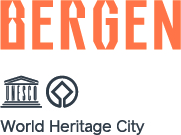How well do you know the different districts in and around Bergen city centre? In this article we present them in more details, so hopefully you will be inspired to explore them on your own.
Sandviken
Sandviken is part of the district called Bergenhus, northeast of the city centre. The Sandviken area is defined as the area between Ytre Sandviken's border in the north by Munkebotnselven, and in the south Mulelven.
Sandviken is also the name of a former larger district in Bergen, which at the time included the districts of Bergenhus, Skuteviken, Ladegården, Sandviken and Ytre Sandviken. The term Sandviken is still used for large parts of these areas. Just make sure you don’t use it in a conversation with anyone who grew up in the area. For them, the boundaries between these areas are still the same as before.

Photo: Gjertrud Coutinho
Sandviken was industrially developed early, with watermills and shipyards. The district was separated from Bergen in 1561, and was first incorporated into Bergen again in 1876.
Sandviken is perhaps best known for its houses. During the 18th and 19th centuries, houses were established on the fields within the port facilities, which gradually formed "hamlets". These hamlets grew along with the activities in Sandviksbukten (Sandvik bay), with small roads connected to the post road through the area. These were small wooden houses on self-owned land, and often the houses had been moved to Sandviken from the areas further out from Bergen.

Photo: Gjertrud Coutinho
Sandviken was also the place where the rich merchants in Bergen went to get away from the city. It was difficult to build large holiday houses in the flammable city of Bergen. Therefore, the rich merchants did this in Sandviken, so that in the summer they could retreat from the city's stench and sewage. In Sandviken, 11 large holiday houses were built between 1780 and 1830. Of these, Christinegård in Mulen is the most famous, with a large French garden and the Greek temple Mon Plaisir.
In Sandviken you will find a good mix of residents. As in many of the other districts close to the city centre, a lot of students live here. But there are also many families living in the city villas.
Experiences in Sandviken
Today there is a lot to experience in Sandviken, especially if you love museums. Here you will find the Old Bergen Museum, the Norwegian Fisheries Museum and the Storeblå exhibition center for aquaculture.
 Norwegian Fisheries Museum. Foto: Silje Katrine Robinson
Norwegian Fisheries Museum. Foto: Silje Katrine Robinson
If you like to go hiking, we recommend the hike up Stoltzekleiven, a steep paved hiking trail and stairs with approx. 722 steps up towards Sandviksfjellet. Afterwards, you can cool off with a swim in the sea and a sauna experience at Heit Måseskjæret.
During the summer, Sandviken Sjøbad, is also a nice place to visit near the Ole Bergen Museum.. Sandviken Sjøbad does not have a beach, but you can dive in the sea from the the diving tower and the floating jetty. There is also a barbecue area and a lawn for relaxation. Many are also exploring the streets with charming wooden houses, a perfect place to fill your Instagram account with great photos.
Bergenhus
As mentioned above, the district of Bergenhus includes a fairly large area in Sandviken, Bergen city centre and Årstad. In the section below we cover the area from Bontelabo to Øvre Dreggsallmenning.
Bergenhus is very central in Bergen's history. In the area where Bergenhus fortress is now located was Holmen, which in the Middle Ages was the site of both the royal court and the cathedral. The construction of Håkonshallen started in 1261 and in the 1270s a castle was built which formed the basis for what is now the Rosenkrantz Tower. Today, the area next to Bergenhus fortress is called Koengen, and is best known as an arena for large outdoor concerts and festivals.

The King Håkon's Hall. Photo: Visit Bergen / Casper Steinsland - visitBergen.com
In this area you will also find one of Scandinavia's biggest attractions, Bryggen, which is included on Unesco's list of world heritage sites. This cultural monument is a remnant of old harbor buildings and one of the most famous urban areas from the Middle Ages in Norway. The Hanseatic League, the German merchants' association, established a foreign office on Bryggen in 1360, and for almost 400 years they dominated the area. The trading houses on Bryggen functioned as warehouses for export and import.
Hidden behind the iconic façade of Bryggen is a "secret" world of passages and dark corridors, which today is inhabited by small shops selling textiles, jewelery, illustrations, knitting, photographs and books. You can also find a handful of restaurants and a charming café.
Experiences in Bergenhus
We have already mentioned Bryggen, Bergenhus Fortress, Håkons hall and the Rosenkrantz Tower, which are all places you should explore when you are in Bergen. In the same area you will also find St. Mary's Church, the oldest preserved building in Bergen, probably built between 1130-1170. The building is exceptionally well preserved, and has been in continuous use since the late Middle Ages. The church was last restored in the 1860s, when the building was restored as it appeared in the Middle Ages.

St. Mary's Church. Photo: Gsfoto
At Vetrlidsallmenningen you will find the lower station of Fløibanen (the funicular), which takes you up to the top of Fløyen, 320 meters above sea level, in just six minutes. Up there awaits a spectacular panoramic view of the city, fjord and mountains, and excellent opportunities for fun for both young and old.
Nordnes
Nordnes is the peninsula that extends west from the city centre, between Vågen on one side and Puddefjorden on the other. The oldest parts of the settlement on Nordnes date back to King Øystein's time, when Munkeliv monastery was built in the period 1107-10, which makes it one of the country's oldest monasteries. The area is still today called Klosteret (the Monastery).
Nordnes peninsula. Photo: Visit Bergen/ Jan M. Lillebø - visitBergen.com
Many people know Nordnes as an area with narrow alleys and beautiful old wooden houses, but the area is characterized by great contrasts in architecture. The contrasts is due to the need for rebuilding after the many fires in the city over the years. Nordnes was also hit hard during World War II, both through repeated bombings and the explosion accident at Festningskaien on 20 April 1944.
Many famous Norwegians were born in Nordnes. Among them you will find Edvard Grieg, Ludvig Holberg, Amalie Skram and Harald Sæverud.
Many of the houses and apartments on Nordnes are inherited, so here you will find a number of families who have lived on Nordnes for many generations. Due to the location close to the city centre, there are many students living here as well, and a number of families with small children who want to live close to the city centre. The inhabitants of Nordnes are very happy on the peninsula and it is popularly called the Republic of Nordnes. Maybe they will demand a secession from Bergen one day? Photo: Gjertrud Coutinho
Photo: Gjertrud Coutinho
Experiences on Nordnes
Bergen's most popular attraction for families is located at the far end of Nordnes. The Bergen Aquarium has given people from Bergen and tourists an exciting encounter with the wildlife from sea and land since 1960, and here you will find the strangest and most beautiful creatures from the tropical rainforest, the spring rocks, the great ocean depths and Arctic regions.
In the same area you will also find Nordnes Sjøbad, where in addition to being able to swim in the sea you can also take a swim in the heated pool. Nearby you will also find one of the more curious sights in Bergen. In Nordnesparken there is a 10 meter high totem pole. Yep, that's right, a totem pole. The totem pole was given as a gift from the twin city of Seattle on the occasion of Bergen's 900th anniversary in 1970.
 Photo: Bergen Byarkiv
Photo: Bergen Byarkiv
At Klosteret in Nordnes, you’ll also find an interesting small museum in the old poorhouse for women. Note that it is usually only open during the summer. Nearby, at Klosteret 16, is the charming little café Løvetann Café & Bistro, which offers delicious organic food, pleasant outdoor seating in the summer, and a cozy atmosphere inside during the winter.

Poto: Løvetann Café & Bistro.
If you want a different kind of experience, we recommend a visit to Magic Ice, an ice gallery & ice bar sculpted by world-famous ice sculptors, who recreate the exhibition several times a year.
Nygårdshøyden
If you walk southwards from Torgallmenningen, and up to "Høyden", you will reach the area called Nygårdshøyden. Nygårdshøyden is probably best known as the students' playground. Here you will find the University of Bergen with the Faculty of Humanities, the Faculty of Mathematics and Natural Sciences, the Faculty of Social Sciences and the Student Centre.
The area is also characterized by old houses and gardens, fences, sculptures and cobblestones that all have a story to tell. In contrast to Nordnes and Sandviken, the buildings in this area are mainly brick houses. The area also includes the charming park called Nygårdsparken, which is a popular place amongst locals on sunny days. The park is designed in English landscape style and has in recent years been refurbished with a new playground for kids and several areas for relaxation.

Photo: Visit Bergen / Casper Steinsland
Nygårdshøyden is the students' stronghold. Over half of the residents in this area are students. The vast majority of them live together with 2,3 or 4 fellow students in shared apartments in the brick houses in the area.
Experiences on Nygårdshøyden
On Nygårdshøyden there are several interesting museums. The University Museum has two departments, natural history and cultural history, and Bergen Maritime Museum is also located in the area. Right next to the University Museum you will find Muséhagen, a botanical gem. It is a protected, old botanical garden with a large and varied selection of about 3000 different plant species.

The University Museum. Photo: Visit Bergen / Casper Steinsland
If you love churches, we can recommend a visit to St. John's Church, which with its reddish color and easily visible location on Sydneshaugen, is a well-known landmark in Bergen. The church was built in 1894 in neo-Gothic style, and boasts both Bergen's tallest church tower with 61 meters and being the larges church in Bergen seating about 1250 people.
Møhlenpris
If you continue further south from Nygårdshøyden and down on the opposite side of the hill, you will come to Møhlenpris. Møhlenpris was previously called Vestre Sydnes and extends from Nygårdshøyden to Damsgårdssundet. The area is named after Jørgen Thor Møhlen, a shipowner, innovator and businessman, who built an industrial area there in the 17th century.
The area has undergone a large transformation in recent years, and has through the Marineholmen project become a district that combines jobs in industry and research with a vibrant living environment. New meeting places, playgrounds, restaurants and gardens are constantly appearing, and Møhlenpris has now got its own beach as well.

Photo: GC Rieber Eiendom AS
With its proximity to the University of Bergen, Møhlenpris is of course a popular place for students. But the area also has many families with children who want to live close to the city centre in a district that is constantly evolving. And who are attracted by the urban lifestyle Møhlenpris offers.
Experiences in Møhlenpris
When you have finished sunbathing at the beach, you should stop by VilVite further down the street. VilVite is a large science center with activities for the whole family. VilVite is all about playing, learning and having fun together in the exhibitions.
Just behind VilVite you can enjoy a dip in the sea and a sauna experience at Heit Sauna Bergen. This is very popular, so make sure you book your time in advance. On the other side of the pedestrian bridge "Småpudden" there is also "Heit Bergen Sauna Laksevåg".
At the Cornerteateret you can catch a theater performance or a concert, or you can just relax in the lower part of Nygårdsparken, as we mentioned in the section about Nygårdshøyden.

Photo: VilVite / Thor Brødreskift
At Bergens Tekniske Museum you can learn about transportation and communication after the technical industrial revolution. A charming and interesting museum run by volunteers.
 Foto: Bergens Tekniske Museum
Foto: Bergens Tekniske Museum
On most Sundays sure you catch a ride with the popular old tram line from the city center to the museum. (check for departures times and opening hours).
When at Møhlenpris, feel free to stroll across the footbridge Småpudden. Just over the bridge, you'll find the café Godt Brød Fløttmannsplassen. Enjoy some delicious pastries during the day and pizza in the evening. There is a nice outdoor seating area, and if you want to take a dip before your meal, they have a convenient outdoor shower available.

Photo: Brød Fløttmannsplassen
Some of the neighborhoods in Bergen city center:

How to get around in Bergen?
Bergen city center is compact and the easiest way to explore the neighborhoods in Bergen city center is to walk. You can also rent a bike from Bergen Bysykkel. They have several stations in Bergen city center where you can pick up and return the bike after use. Rent a bike for a trip, or a day, or whatever suits your needs. A fun and efficient way to get around!

Photo: Hilde Bang Foss/Bergen Bysykkel
Whether you want to explore the city centre of Bergen, the districts and surrounding neighborhoods, or are ready to move further out into the region around Bergen, there is much to experience. Read more about Bergen Region here.
 to add an item to your Itinerary basket.
to add an item to your Itinerary basket.










